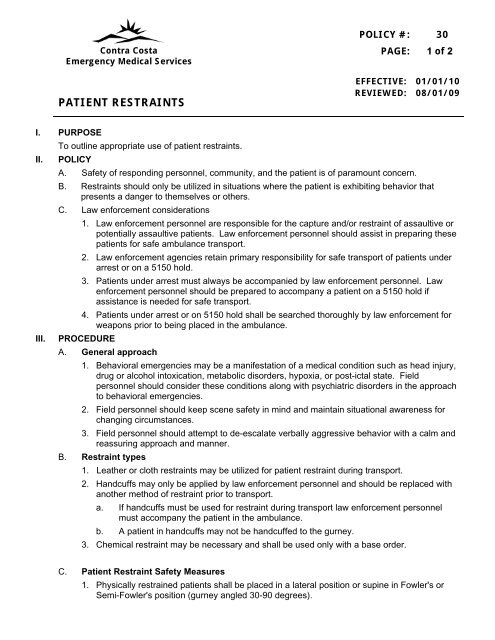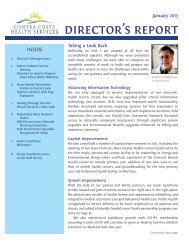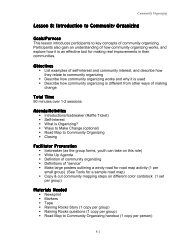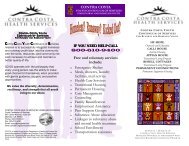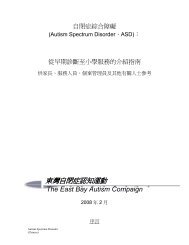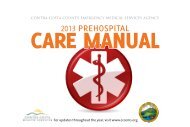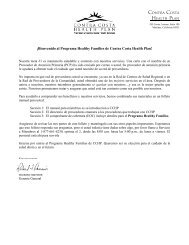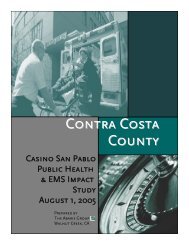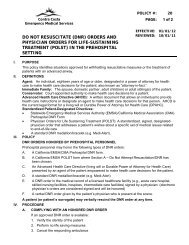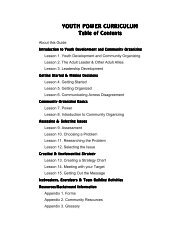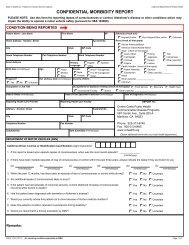EMS Policy Manual - Contra Costa Health Services
EMS Policy Manual - Contra Costa Health Services
EMS Policy Manual - Contra Costa Health Services
Create successful ePaper yourself
Turn your PDF publications into a flip-book with our unique Google optimized e-Paper software.
<strong>Contra</strong> <strong>Costa</strong><br />
Emergency Medical <strong>Services</strong><br />
PATIENT RESTRAINTS<br />
POLICY #: 30<br />
PAGE: 1 of 2<br />
EFFECTIVE: 01/01/10<br />
REVIEWED: 08/01/09<br />
I. PURPOSE<br />
To outline appropriate use of patient restraints.<br />
II. POLICY<br />
A. Safety of responding personnel, community, and the patient is of paramount concern.<br />
B. Restraints should only be utilized in situations where the patient is exhibiting behavior that<br />
presents a danger to themselves or others.<br />
C. Law enforcement considerations<br />
1. Law enforcement personnel are responsible for the capture and/or restraint of assaultive or<br />
potentially assaultive patients. Law enforcement personnel should assist in preparing these<br />
patients for safe ambulance transport.<br />
2. Law enforcement agencies retain primary responsibility for safe transport of patients under<br />
arrest or on a 5150 hold.<br />
3. Patients under arrest must always be accompanied by law enforcement personnel. Law<br />
enforcement personnel should be prepared to accompany a patient on a 5150 hold if<br />
assistance is needed for safe transport.<br />
4. Patients under arrest or on 5150 hold shall be searched thoroughly by law enforcement for<br />
weapons prior to being placed in the ambulance.<br />
III. PROCEDURE<br />
A. General approach<br />
1. Behavioral emergencies may be a manifestation of a medical condition such as head injury,<br />
drug or alcohol intoxication, metabolic disorders, hypoxia, or post-ictal state. Field<br />
personnel should consider these conditions along with psychiatric disorders in the approach<br />
to behavioral emergencies.<br />
2. Field personnel should keep scene safety in mind and maintain situational awareness for<br />
changing circumstances.<br />
3. Field personnel should attempt to de-escalate verbally aggressive behavior with a calm and<br />
reassuring approach and manner.<br />
B. Restraint types<br />
1. Leather or cloth restraints may be utilized for patient restraint during transport.<br />
2. Handcuffs may only be applied by law enforcement personnel and should be replaced with<br />
another method of restraint prior to transport.<br />
a. If handcuffs must be used for restraint during transport law enforcement personnel<br />
must accompany the patient in the ambulance.<br />
b. A patient in handcuffs may not be handcuffed to the gurney.<br />
3. Chemical restraint may be necessary and shall be used only with a base order.<br />
C. Patient Restraint Safety Measures<br />
1. Physically restrained patients shall be placed in a lateral position or supine in Fowler's or<br />
Semi-Fowler's position (gurney angled 30-90 degrees).


